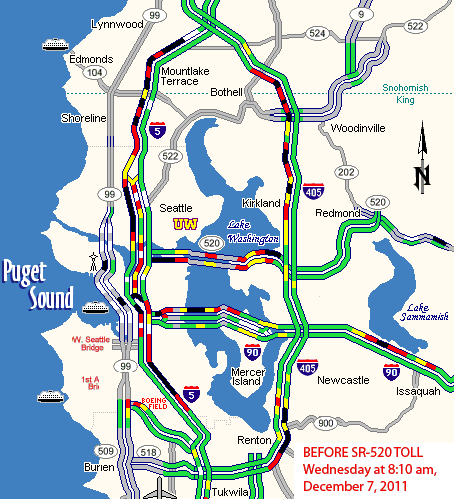Just to be clear: it’s way too early to be sure how the new SR-520 tolls will affect Seattle traffic over the long haul. Still, as an I-5 commuter, I’ve found the effects of tolling both dramatic and fascinating.
Take a look at the animation below, comparing yesterday morning’s rush-hour with traffic from 4 weeks prior. Not only was 520 a breeze after tolling started, but the traffic seemed to ease on I-5 southbound as well—and perhaps even on 405 southbound north of the turnoff to 520.
 I chose December 7 more or less at random, but the traffic map for that day is familiar: Wednesday morning rush hour is typically the most congested day of the week, with long backups on I-5 southbound heading towards the turnoff to SR-520 (the northern of the two cross-lake routes). Yesterday, though, it was smooth sailing into downtown.
I chose December 7 more or less at random, but the traffic map for that day is familiar: Wednesday morning rush hour is typically the most congested day of the week, with long backups on I-5 southbound heading towards the turnoff to SR-520 (the northern of the two cross-lake routes). Yesterday, though, it was smooth sailing into downtown.
Obviously, we shouldn’t read too much into a this kind of tiny sample. There could have been lots of reasons why traffic was bad on December 7, and why it was light on January 4. Still, both my personal experience and my read of the trends so far suggest that the 520 tolls have shifted traffic patterns dramatically. And that provides at least some evidence that tolls really can be an effective tool in managing congestion and traffic flows. (Just to be clear, I’m not saying that the traffic shifts automatically demonstrate that tolls are a good idea, or that the net economic impacts of the current tolling system are fair. I’m only saying that the tolls appear to be having a major impact on traffic.)
A few thoughts:
- I have to wonder whether the tolls on 520 are reducing overall traffic volumes across Lake Washington, rather than just shifting drivers from 520 to I-90. It’ll be interesting to see how the numbers fall out over the next few weeks—but if we’re paying for new roads with tolls, and tolls reduce traffic volumes, then the region might have to rethink whether we actually need all of the expensive new road projects that we’re planning. (And that’s especially true if the tolls only pay for a fraction of the cost of the road projects in the first place. If drivers had to pay the full cost of the roads built for their use, you can be sure that they’d do a lot less driving.)
- I think that I-5 traffic trends over the next few months will be as instructive as those on 520 and I-90. If the 520 tolls have eased the rush hour crush on I-5, then perhaps we’ll see what Brookings Institution researcher Anthony Downs calls the “Triple Convergence” effect: free flowing traffic on I-5 during the morning rush could attract drivers from other modes, routes, or times of day, gradually boosting traffic volumes. And that could mean that the congestion reductions resulting from the 520 tolls could be very short-lived.

Comments are closed.